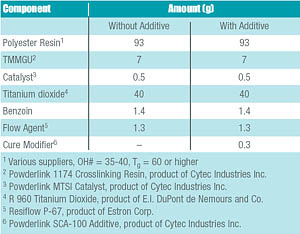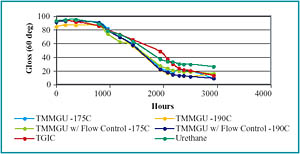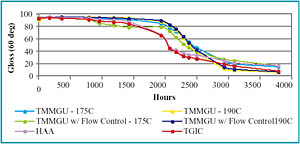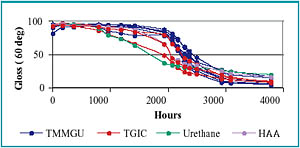The growth rate of powder coatings has slowed from the 1980s' and 1990s' double-digit increases, but opportunities exist for expansion into new applications and steady growth in existing applications. Research by the raw-material suppliers and paint manufacturers on how to use the advantages inherent in powder coatings to capture even greater market share from traditional application techniques continues. Double-digit growth rates are still possible in some market segments.
Coatings that have been growing at rates above the general market trend are "superdurable" powder coatings. Powder coatings that can be termed superdurable have weathering characteristics that make them attractive for extended outdoor use on products such as architectural extrusions and lawn and garden items.
Superdurable resins are designed specifically to withstand long exposure to the elements, especially the effects of sun and rain. Studying the long-term exposure of these powder coatings would require years before any differentiation would occur between coating chemistries. Accelerated weathering tests have been designed to shorten the exposure time. Unfortunately, the results occasionally do not match what would have occurred had nature been allowed to run its course.
Atlas Weather-Ometer testing has been shown to correlate reasonably well with Florida exposure studies while accelerating the weathering effect. The equipment's biggest advantages are availability and ease of use. Using the weatherometer as a tool to compare similar coatings tested simultaneously provides a screening tool by which to select panels that warrant the expense and time commitment of Florida testing.
Superdurable powder coating market
There are currently two major markets to consider when determining the potential for growth of these products in the next five to 10 years: Europe and North America. Although the Latin American and Asia/Pacific regions have a lot of potential, they tend to lag behind Europe and North America. Powder coating companies in the Latin America and Asia/Pacific regions are often owned, wholly or in part, by larger parent companies in the North American and European regions.Europe leads the superdurable powder coating market, just as they led the initial introduction of powder coating into a widespread base of applications. In 1997, outdoor durable powder coatings used for aluminum and other outdoor structures comprised 20% of the total powder coatings market in Europe, according to Irfab Chemical Consultants (Brussels, Belgium). In Europe, more than 92% of the exterior, durable factory-applied coatings for architectural metal are powder coatings, with all but 6% in polyester-based coatings. Superdurable powder coatings have a 20- to 25-year life expectancy on architectural metal parts in European exposures.
The North American market for superdurable polyester has not yet reached this level. In North America, only about 10% of the crosslinkers consumed are used in superdurable coatings. Most of the applications are in general metal or garden furniture; there is very little penetration into the architectural metal or structural markets. These applications require better outdoor durability and have a projected annual growth rate of 11 to 13%. Due to the substantial opportunities that are available in the exterior durable architectural market, there is a now a push underway to use powder coatings for these applications in the United States.

Available crosslinkers
Unlike with traditional liquid coating chemistries, there are surprisingly few crosslinkers available to the powder coating formulator. Each crosslinker has distinct advantages and disadvantages. The backbone resins most commonly used in superdurable powder coatings are polyesters. The crosslinkers most commonly used for both hydroxyl and carboxyl polyesters are listed below with their attributes in Figure 1 (page 17). Urethanes, triglycidyl isocyanurate (TGIC), tetramethoxymethyl glycouril (TMMGU) and hydroxy-alkylamine (HAA) are all commercially available crosslinkers for powder coatings.Due to concerns with the toxicity of TGIC, powder coatings that contain more than 0.1% of the compound would have to carry a warning label that included the European Toxic label, which includes a skull and crossbones logo. The performance of TGIC in weathering is quite good, so this has significantly affected the use of the crosslinker in superdurable architectural coatings. If suitable replacements are found that can perform as well or better, they could be used to replace this compound. Clearly a need has developed in the European marketplace.
The United States does not yet have the same labeling requirement and there are no indications that a similar labeling requirement is imminent. However, most of the major powder coating producers operate globally and wish to have formulations that are universal. These requirements have encouraged North American producers to also look at alternatives to TGIC.
Glycouril-based crosslinkers are part of a larger class of crosslinkers called aminoplasts. Aminoplasts are commonly used in high-solids coatings that are now the industry standards.
Melamine formaldehyde coatings are used in a wide range of applications, including high-performance-driven uses such as automotive applications. Although the melamine-based crosslinkers have good outdoor durability, the glycouril-based crosslinkers are often chosen when weathering of the coatings is a predominant concern.
Tetramethoxymethyl glycouril (TMMGU) is an unusual compound in this family because it is a solid at room temperature while most similar compounds in the family are liquids. Its 120°C melting point makes it ideally suited as a crosslinker for powder coatings. It was suspected that if the glycouril-based crosslinkers showed improved weathering characteristics over the other amino resin crosslinkers in liquid coatings, this might also be true for powder coating applications.

Experimental procedure
In order to compare the weathering of various crosslinkers in superdurable polyester resins, several resin suppliers were contacted for samples of their backbone resins. Hydroxyl functional backbones were obtained to prepare TMMGU-crosslinked formulations. Resin suppliers were also asked to supply panels that contained standard, superdurable TGIC-crosslinked powder coating formulations. Manufacturers were invited to submit other crosslinking chemistries if they had an interest in comparing the performance of other backbone resins or crosslinkers. Due to the nature of the competitive information being gathered, the companies do not know the identity of the other participants in the study and they will not be identified here. The suggested formulation for all the panels submitted for weathering required different backbone-to-resin ratios based on the chemistries chosen. All submitted panels were to include 40% TiO2 and were specifically not to include light stabilizers of any type. A specific high-quality, outdoor-durable grade of titanium dioxide was requested because pigmentation can have an effect on the durability of a coating.The TMMGU-crosslinked panels were prepared in a standard formulation without the addition of a cure-modifying additive, and a second time including an additive. The additive was used to increase the pinhole-free film thickness of the test panels. With the addition of the cure-modifying additive, the thicknesses achievable can be up to 5 mils without defects. Panels for this study were sprayed at a film thickness equivalent to 2.5 to 3.0 mils when cured. Test panels were cured at both 175 and 190°C.
All TMMGU-crosslinked powder coatings were prepared using the formulations shown in Figure 2 (previous page). Panels were subjected to accelerated weathering in an Atlas Weather-Ometer under the SAE J1960 JUN89 automotive exposure conditions. Panels were checked regularly for loss of gloss using a DRLange Reflektometer at 20- and 60-degree reflected angles.

Results and discussion
The three resin producers who chose to participate in this study had the opportunity to choose the backbone they would most want to have exposed to weathering and which competitive crosslinking chemistries they would like to include. All had been specifically requested to submit TGIC-based panels for a control since the behavior of TGIC in superdurable weathering is well known.
Company A chose to submit both a TGIC and urethane panel for comparison to the TMMGU-crosslinked panels. The results are shown in Figure 3. Compared to the other companies in the study, all of these experimental samples did not do as well at retaining their gloss. All of the samples lost 50% of their initial gloss in the 1,500- to 2,000-hour range.

Company B (Figure 4, previous page) chose to include the TGIC and HAA-crosslinked test panels. The TGIC and HAA panels show typical behavior as seen in other weatherometer testing. The TMMGU-crosslinked panels are superior in gloss retention between 1,500 and 2,700 hours. By 3,000 hours, all the samples have begun to chalk, and the measurements were discontinued. Since TGIC and HAA panels are in carboxyl functional resins and the TMMGU samples are in a hydroxyl functional backbone, it is not clear whether the backbone resin, crosslinker or the combination is giving the better performance.

Similarly, the addition of the flow-control additive has had little effect on the behavior of coatings in weathering. The effect of cure temperature and the addition of the flow-control agent did not appear to affect the weathering behavior of any of the three competitive resins.

Conclusions
TMMGU-crosslinked powder coatings exhibit similar or better accelerated weathering behavior when compared to TGIC and other crosslinking chemistries. Unlike the TGIC coatings, the glycouril-based powder crosslinker does not have to be labeled as a toxic compound. In Figure 6, the panels submitted by the companies in this study are shown compared to the TMMGU-crosslinked systems.The urethane and TGIC panels of Company A are included for comparison only but are not thought to be indicative of the typical performance. The two TGIC panels and one HAA panel are similar in behavior to previously reported results for these chemistries. The TMMGU-based samples behave in a similar fashion and in fact show slight improvement over the TGIC and HAA-based panels overall. Although weatherometer testing alone cannot assure good behavior in outdoor weathering, it is a valuable tool when comparing similar coatings in accelerated testing.
Future work will include hydroxyl functional polyester resins obtained to better identify the effect of crosslinker on the weathering of the superdurable hydroxyl-functional backbones. The other major types of highly weatherable powder coatings are based on acrylic resins. The weatherability of these backbone resins, both hydroxyl and carboxyl functional, would also be of interest.

Report Abusive Comment